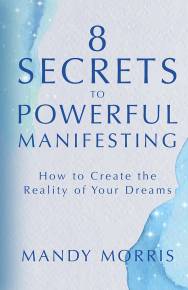Mandy Morris, an entrepreneur, philanthropist, and manifestation expert—is the creator of Authentic Living, an online company designed to help individuals reconnect with their authentic selves to find purpose, peace, and deep healing. We talked with her about her new book, 8 Secrets to Powerful Manifesting: How to Create the Reality of Your Dreams ($24.99, Hay House, 2022).
Taste for Life: In your book, you talk about how triggers can negatively affect emotions and spiral us into states of stress, anxiety, and anger. Can you explain what a trigger is, why it impacts us so strongly, and how we can interrupt the patterns that cause us to downward spiral?
Mandy Morris: The biggest recent example is COVID. COVID did a doozy on us because the situation was constantly changing.
In the beginning, we thought we were all going to die, and we might not make it. Over time, the triggers changed to be more about whether someone wanted to wear a mask or get vaccinated. It was stressful, politicized, and weaponized—it even broke up families.
We were all constantly getting triggered, and we never knew where the trigger was going to come from. It could be when we walked into a store, and someone was freaking out about a mask. The triggers changed to less scary things but the response became so solidified that the trigger produced the same intensity of feeling as it did when we first thought we were all going to die.
The thing that messes us up is not the trigger in and of itself. It’s that little bit of time before the brain decides what something is going to mean, which triggers the reaction.
My book shares pattern interrupt techniques, which are the ability to stop the brain from firing the way it typically fires. What we want to do is get a pattern interrupt that works so that when the trigger occurs and we have an amount of space between trigger and thought, we start telling ourselves something different than we did before. That allows our brain to neurologically rewire itself so that those triggers no longer affect us in an inappropriate way.
TFL: Triggers being what they are, how does someone get that space between trigger and thought a bit more spacious to prevent habitual spiraling?
MM: You can use COVID as an example, or insert relationship issues, or body image, whatever it is, there are certain things that we consistently tell ourselves. First and foremost, we have to take a couple of steps back and say, “What are my triggers?”
For myself, if something new shows up, I give myself 24 to 48 hours to document it. I tell myself, “Instead of getting emotional, I’m going to get curious.” There’s magic in curiosity. Say I realize I’m very angry about something, and I don’t know why. I say, “Let me think about this for a second and figure out what I’m telling myself that is making me so angry.”
When we know what we get triggered by, once it happens, we’ve already started being more proactive versus reactive. In this way we assume responsibility for our reactions instead of feeling blamed or victimized.
This approach also empowers me because I’m back in the driver’s seat of, “Okay, I can choose not to get emotional here.” If I know what I’m telling myself, that will help me.
Then I need to take it a step further. I need to ask if my response is appropriate or if my thoughts are even true. It’s not that we’re trying to be positive or put a spin on it in a toxic positivity way. It’s just that I don’t want to be lying to myself. I’m looking for the truth, which means that my bias has to get out of the way.
TFL: Often our emotional response to a trigger is so powerful, it seems like whatever we’re feeling has to be the truth. I’ve heard it said that when you’re having, or you see someone else having, an emotional reaction that outsizes the incident that actually happened, you can tell the person has been triggered.
MM: Yeah, it’s not about the now. When we start doing pattern interrupts, we start condensing the time frame, so the pattern gets smaller.
Before, if I got triggered about something, I was pissed for hours. Hours could spiral into days. I had to step back from what I was telling myself and say, “This isn’t true or this doesn’t have to be true.”
Over time, that period of hours condensed and condensed and condensed until it became a period of seconds. I was more able to note, “Oh, wait a second. That’s one of my triggers. Probably not true. Let’s find out and get curious instead of wreck my whole day over this frustration that may not even be real.”
TFL: How do we incorporate the pattern interrupts into our lives?
MM: I like to break it down into three simple ways. We want a physical pattern interrupt, a mental or emotional pattern interrupt, and a spiritual pattern interrupt.
I want people to play around. For a physical pattern interrupt, try out a few things. Someone might drop down and do 10 push-ups. I have a client who will jump up and down and say, “I’m a star!” It makes her laugh because she feels so stupid. I will dance in front of the mirror as ridiculously as I possibly can and watch different body parts flop around, and I’m like, “Okay, I can’t be upset right now. This is just too good.”
For mental and emotional pattern interrupts, I used to imagine Oprah saying, “Honey, we got stuff to do. We’ve got people to help.” Some people might ask, “What am I feeling right now?” They’ll take 10 deep breaths, basic mindfulness.
Then spiritual, they can pray to their higher power. They might drop into a short meditation or journal.
The intention is the most important with a pattern interrupt. Does it actually work? It’s okay if some do and some don’t, but we’ve got to try some things to get into a different emotional state, even if it’s just a little bit different.
TFL: That sounds like creating space.
MM: Yes. Pattern interrupts aren’t meant to get us to super high states. They’re just meant to get us out of the state we’re in and maybe a couple notches up. Even if you just get 1 percent better each day and the trigger gets a tiny bit less serious for you. You don’t have to go up to enlightenment. We’re just looking for a few vibrational steps up until the trigger no longer exists.
TFL: Is there anything else you wanted to talk about from your book?
MM: The biggest thing I tell people is, you’ve got to get familiar with the frequency of being really connected. I call it to God, but connected to yourself, whatever feels right. It’s this state of being, just energy or neutrality, pure potential.
When you sit in that space, you try to not let your head get in the way. You just ask yourself, “What’s next?” And the first answer that comes through, and it could be as simple as, “Go drink a cup of tea.” And then you get to ask again.
You might just get little bread crumbs, the universe is funny like that. It’s just getting yourself into that beautiful calm, centered state. After that, it’s surrender. You’re trusting and you’re surrendering.
I’ve moved to different states because of that guidance. I have done the craziest of things. But I always know that I’m following what I’m supposed to do for the world, and it will always turn the way it is supposed to, and it will be beautiful.







